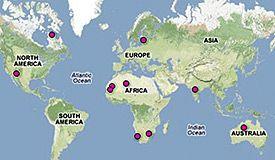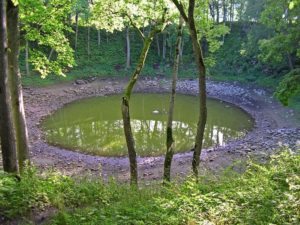World 🢖 Asia 🢖 India 🢖 Maharashtra
Impact craters 🢔 Geological wonders 🢔 Categories of wonders
Wonder
Lonar crater
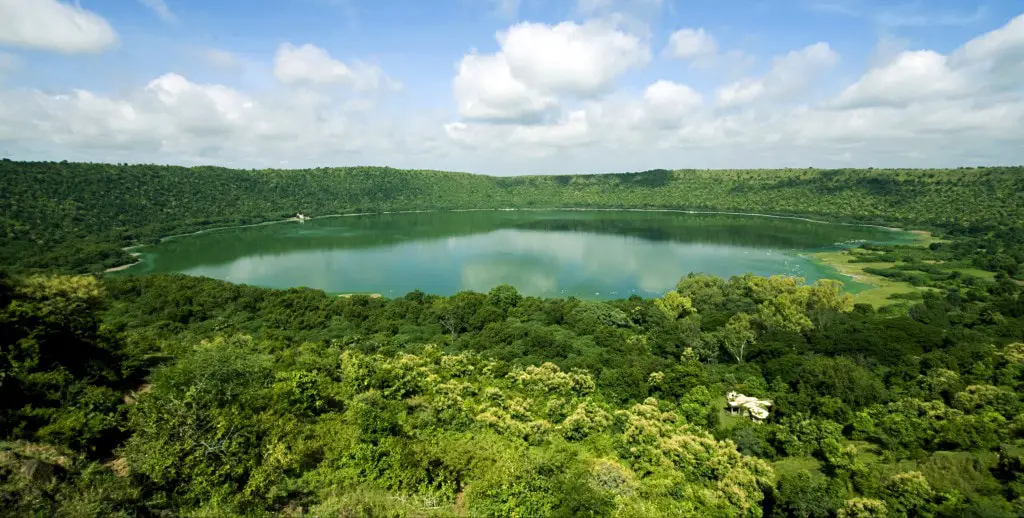
 In short
In short
Lonar crater is unique impact structure – the only large impact crater in basalt on Earth with unusual soda lake in it.
 49.5%
49.5%
GPS coordinates
Location, address
Name in Marathi
Diameter
Depth
Age
Map of the site
If you see this after your page is loaded completely, leafletJS files are missing.
 In detail
In detail
Description
Lonar crater has formed in the approximately 65 million years old Deccan Trap basalt. Layer of basalt here is approximately 400 m thick. Research shows that initially this crater was approximately 230 – 245 m deep, but now it is less than 150 m deep.
Crater has slightly oval form, with a diameter of 1,800 m.
Inner slopes of crater are 5 – 25° steep.
Lonar crater has distinct rims and is visually one of most prominent impact craters on Earth.
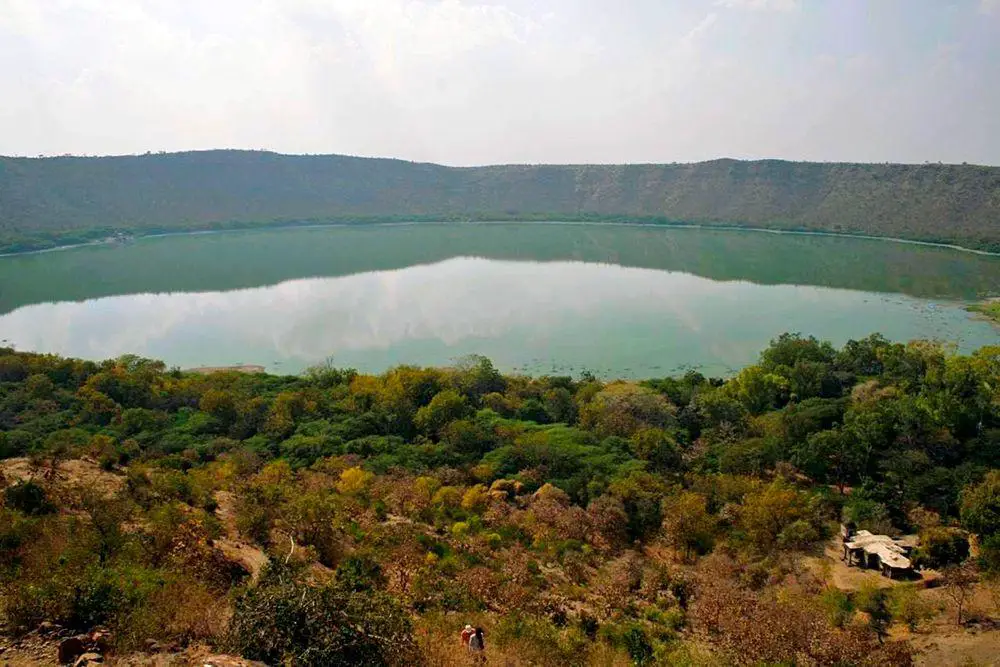
Meteorite impact
At some time specialists considered that this crater was created by an eruption of volcano but now it is proved that meteorite impact is the cause. There have been found the characteristic planar deformation structures in the grains of feldspar, shatter cones. Around the crater is ejecta blanket – layer of debris, which fell on the ground after the impact. Tectites – pieces of melted silica – have also been found.
Meteorite most likely came from the east, it hit the ground at 30 – 45° tilt.
Earlier, basing on the data of thermoluminescence analyses, it was believed that meteorite fell 52 thousand years ago.
Recent studies 40Ar/39Ar analysis though show a different age – 570 000 ± 47,000 years (1, 2). This method seems to be more reliable, also the crater seems to be too much eroded for a period of 50,000 years.
This is the only impact crater fully created in basaltic rock. Research of Lonar crater provides valuable information about the consequences of meteoritic impact on such planets as Mars.
Ambar lake – another impact crater?
700 m to the north of Lonar crater is located smaller crater – Ambar lake crater (Little Lonar).
Ambar lake also is oval shaped, with 250 – 290 m diameter, with approximately 6 m high rim around it. Lake is located some 5 m below the rim.
Although it is speculated that this smaller crater might have been created by the debris from the large crater, it most likely was created by another piece of meteorite – thus this is one more impact crater.
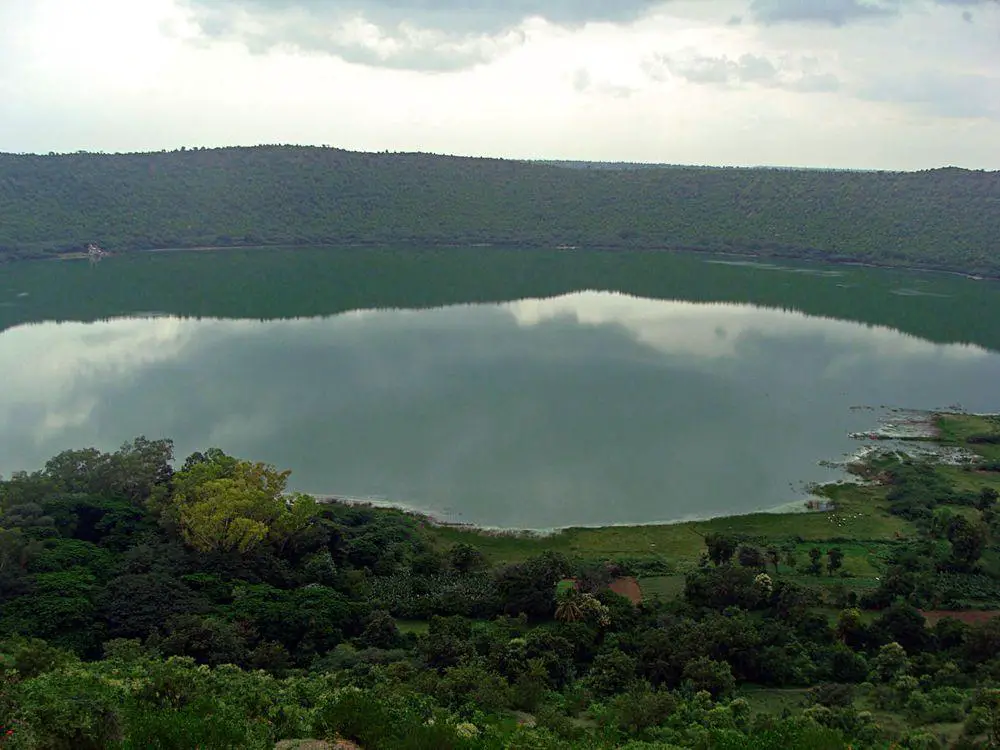
Lonar lake
In the large crater, 137 m below the crater rim is located a unique lake – Lonar lake. The diameter of this shallow lake is 1.2 km. The uniqueness of the lake is defined by the following factors:
- This is the only lake in the world, which is located in basaltic meteorite crater;
- Tall rims of crater protect the lake from the impact of winds, different parts of the lake do not get mixed, lake basin has its own regime of increased humidity and temperature.
Lonar lake is a saline soda lake with a high content of dissolved carbonates. The salinity of the lake is fluctuating – in the dry period the lake level falls and salinity increases, in the rainy period level rises and water is less salty.
Near the banks of the lake are several freshwater springs – due to this and due to small streams of rainwater the water near the shore is less saline. Near the shores pH of water is neutral – 7, but in the middle water can be very saline and pH can reach 11.
Unusual ecosystem
Each zone in the lake has its own ecosystem. More unusual is the life in the centre – in alkaline zone, where live specific microorganisms, e.g. Halomonas sp., Paracoccus sp. Klebsiella sp., Slackia sp. Actinopolyspora sp.. Some of these microorganisms can survive only in a very alkaline environment and can survive in inorganic environments. These microorganisms are capable to fix atmospheric nitrogen.
Outer zone of the lake is more friendly to common inhabitants of lakes in India – here are seen numerous wading birds, along the shores are seen lizards, gazelles, and other animals. For several centuries local people are mining salts from the lake.
Slopes of the lake also have their own, specific ecosystem. Around the lake is a belt of alkaline mud, which is inundated in rainy periods.
Further grows a belt of acacia trees and then starts jungle with tamarinds, teak trees, and other trees.
Temples
India is a land of temples and the Lonar crater is not an exception. It seems this unusual lake has been sacred for a long time. Currently at the banks of the lake are eight temples – Vishnumandir, Wagh Mahadev, Mora Mahadev, Munglyacha Mandir, Goddess Kamalaja Devia, and three more temples. Some are located higher above the lake, some are partly inundated. Best preserved is Kamalaja Devi temple, which is adorned with sculptures.
Endangered lake
This unique lake with its fragile ecosystem is endangered. India is densely populated and, unfortunately, this density creates increasing problems – the lake is increasingly polluted with sewage from the nearby villages, it happens that trees on the slopes are felled, grazing animals come here. Religious festivities take place at the lake and guests leave garbage and graffiti here.
Crater is protected as a geological landmark, but the protection regime for this unique natural landmark should be more strict and adapted to its specifics. There are initiative to improve the situation (E.g. "Save Lonar") – let’s hope that the unique qualities of the lake will be preserved for future generations.
References
- F. Jourdan, F. Moynier, C. Koeberl. First 40Ar/39Ar Age of the Lonar Crater: a ˜0.65 MA Impact Event?., 41st Lunar and Planetary Science Conference (2010). Accessed on December 29, 2012.
- F. Jourdan, F. Moynier, C. Koeberl, S. Eroglu. 40Ar/39Ar age of the Lonar crater and consequence for the geochronology of planetary impacts. Geology July 2011 v. 39, no. 7, p. 671-674. Accessed on December 29, 2012.
Lonar crater is included in the following articles:
 Linked articles
Linked articles
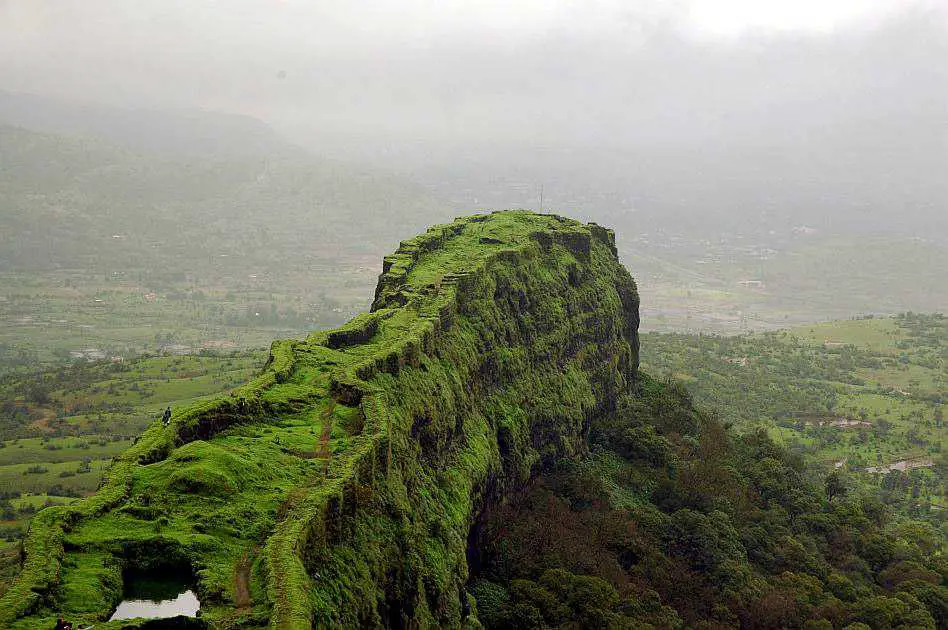
Wonders of Maharashtra
Maharashtra is a truly splendid state. It has everything – enormous metropolises and countless waterfalls in mountains, urban decay, and architectural splendor, remnants of millennia-old Harappan towns, and modern, very expensive architecture.
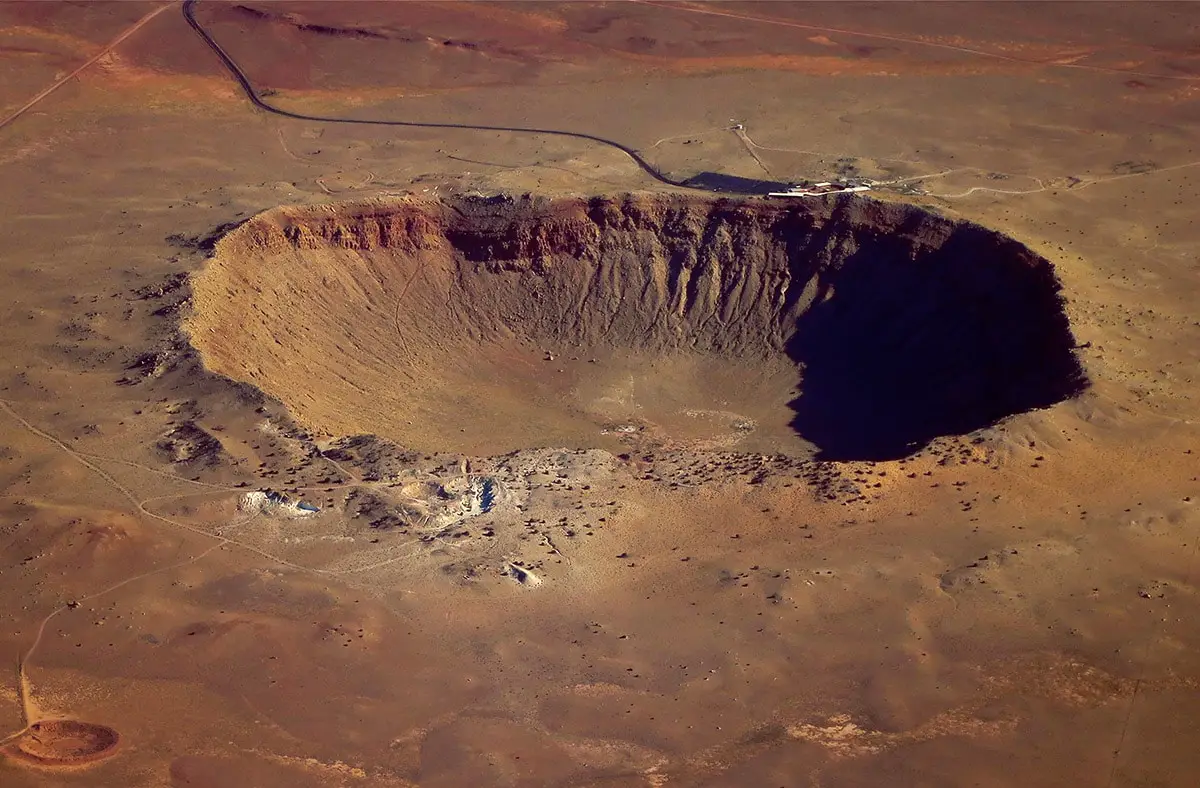
Impact craters
There are many pieces of solid matter flying around in space. And VERY frequently they fall on the surface of the Earth. There are estimates that every year on Earth fall 18,000 – 84,000 meteorites larger than 10 grams: e.g. one meteorite every 6 – 30 minutes.
This category includes outstanding impact craters – detectable scars on the surface of Earth left by a body coming from outer space. The category includes also meteorites – natural objects from outer space.
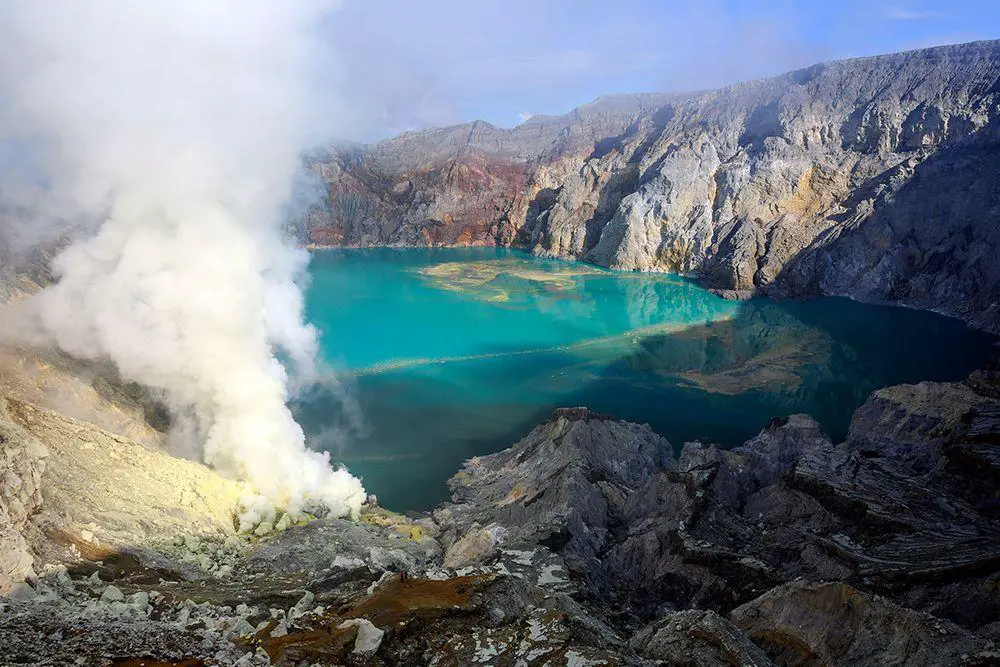
Lakes and streams
There are many factors that can make lakes, sea bays, or rivers unusual. Some lakes have unusual chemical properties and even do not contain water at all – such as lava lakes. Others may have unusual animals living in them or… legends about such animals.
 Recommended books
Recommended books
100 Wonders of India
Travelers in ancient times marveled at seven man-made wonders located in various countries bordering on the Mediterranean. Over hundreds of years since then, civilizations have risen and declined, the world has been built and rebuilt, and many more works of human genius lie scattered across geographies and eras. Exploration and discovery have revealed more of nature’s wonders too, that stretch and humble human imagination.
Net of Magic: Wonders and Deceptions in India
Vast like the subcontinent itself and teeming with outrageous and exotic characters, Net of Magic is an enthralling voyage through the netherworld of Indian magic. Lee Siegel, scholar, and magician, uncovers the age-old practices of magic in sacred rites and rituals and unveils the contemporary world of Indian magic of street and stage entertainers.

